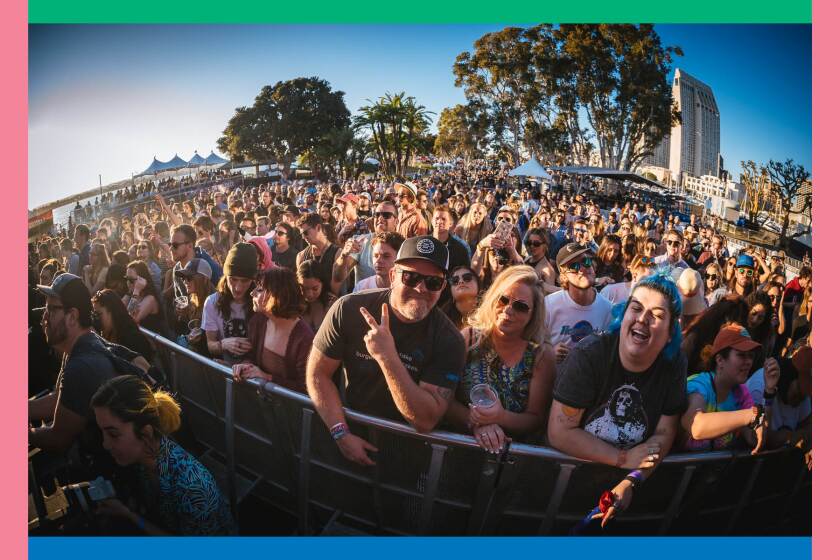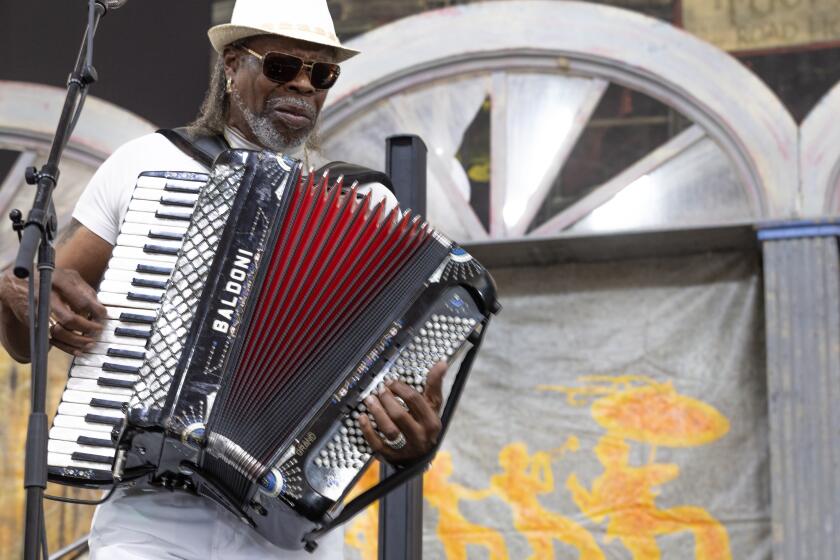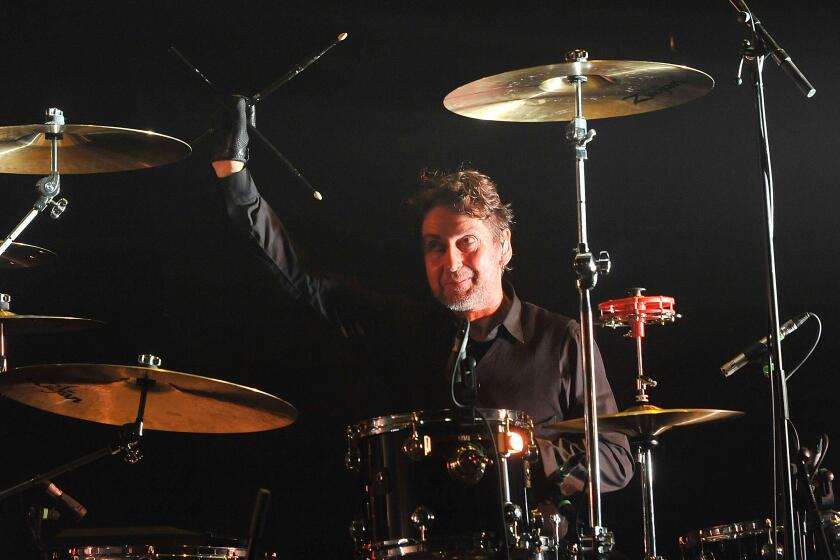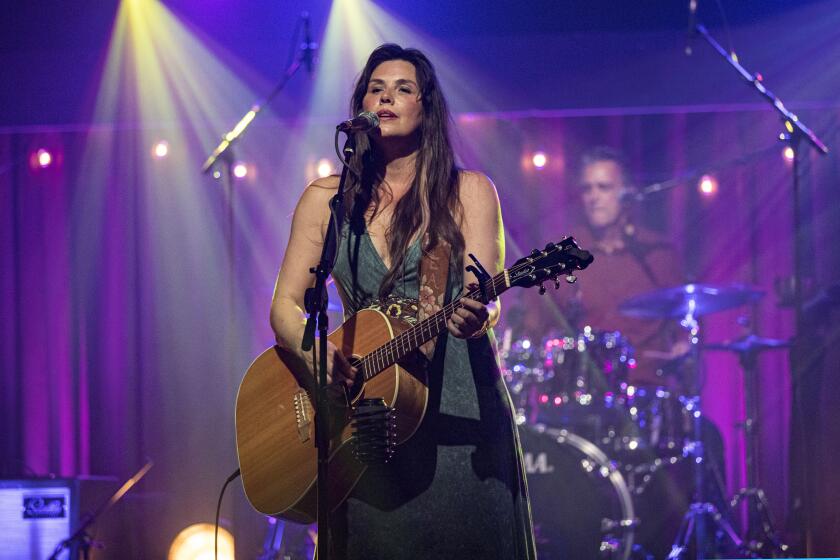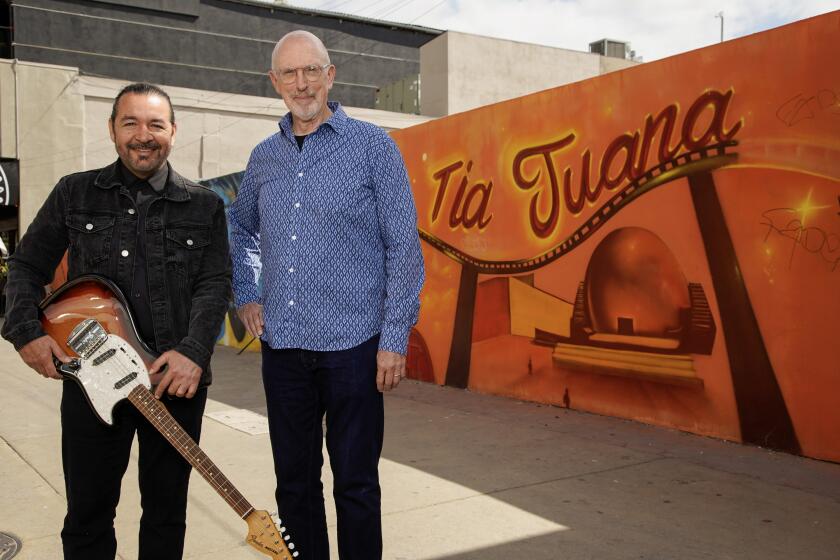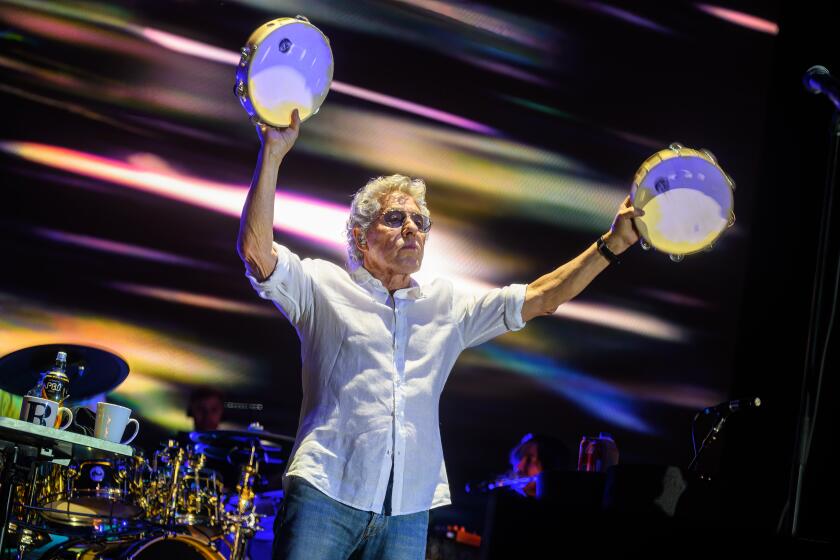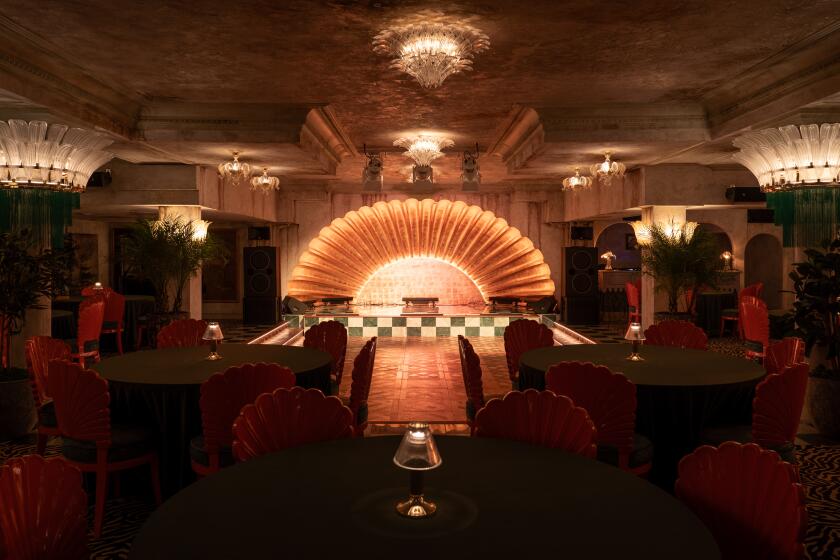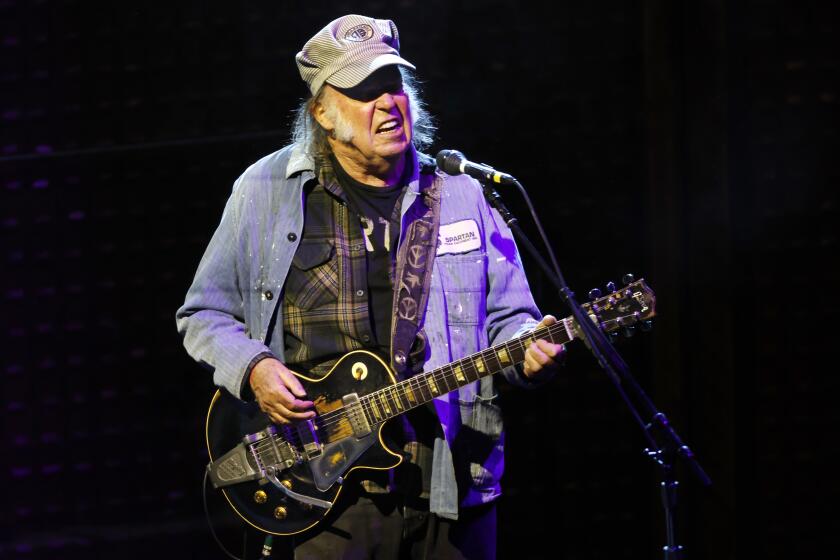Appreciation: Sinead O’Connor, dead at 56, was a singular artist: ‘I would have liked to be a priest,’ she told us in 2013
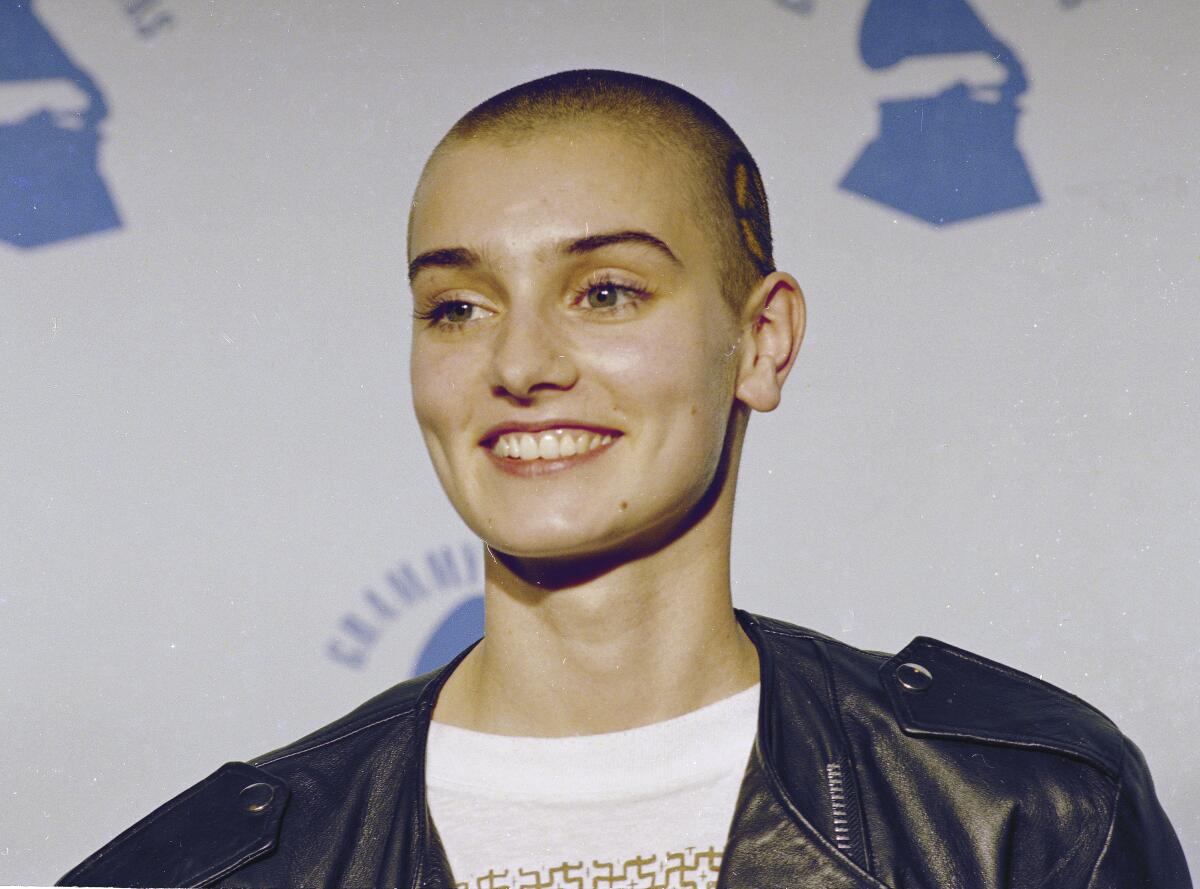
‘I would like to be remembered,’ she told us, ‘as a loving mother and grandmother. I’d like to be the rocking-est granny! I’d like to go out like (pioneering blues and rock singer) Big Mama Thornton.’
In a world of cookie-cutter pop-music stars and automatons, Sinéad O’Connor was a one-off. The Irish singer-songwriter — whose death at the age of 56 was reported Wednesday by her family — was a singular artist who marched to the beat of her own, very idiosyncratic drummer.
She not only courted controversy with her take-no-prisoners approach, she welcomed it.
Or, as O’Connor said in a 2013 San Diego Union-Tribune interview: “I think artists can be inspiring, as long as we’re courageous enough to be ourselves and to be bullied, but not run away.”
This Dublin native could have taught master classes in not running away, no matter how intense the blow-back could be — and, in her case, it was often withering.
O’Connor’s area debut concert at the San Diego State University Open Air Theater on May 19, 1990, was electrifying and then some.
No cause of death has been disclosed yet for the troubled musician, whose struggles with mental health issue were a matter of record.
However, in what appears to have been the final post on her Twitter page last week, she described herself as an “un-dead night creature” since the 2022 suicide of her son, Shane. She described him as the “love of her life” and the “only person who ever loved me unconditionally.” She was, she wrote, “lost” without him.
O’Connor’s many achievements and controversies will no doubt be recounted in a plethora of obituaries and tributes. But no one articulated her views as well as O’Connor herself.
Here is our complete 2013 interview with this one-off musician.
Sinéad O’Connor talks music & controversy
BY GEORGE VARGA
Nov. 13, 2013, San Diego Union-Tribune
It’s perfectly logical to surmise that Sinéad O’Connor might like to be remembered for her luminous singing — and, perhaps, as a lightning rod for social discourse on everything from religion and mental health to Miley Cyrus (more about her later) and the state of women in pop music.
Logical, perhaps. But, as O’Connor quickly notes, not remotely accurate.
“How would I like to be remembered?” mused the Irish singer-songwriter, whose Tuesday concert here at the Belly Up was canceled (along with five other 2013 tour dates) after she was diagnosed with acute laryngitis.
“I guess the same as any other woman. What’s the best way to put it? As a loving mother and grandmother. I’d like to be the rocking-est granny! I’d like to go out like (pioneering blues and rock singer) Big Mama Thornton.”
Blues-drenched vocal dynamo Thornton recorded the original 1952 version of “Hound Dog,” which was covered four years later (in an almost note-for-note remake) by Elvis Presley. Is O’Connor aware that Thornton, whose stage name accurately reflected her imposing stature, was known to often carry a knife?
“Did she?” O’Connor said, before mischievously adding: “Well, that’s not legal in Ireland.”
She delivered this dry witticism with the pinpoint timing of a seasoned musician.
Fortunately for O’Connor, she doesn’t need a knife to fend off any detractors. Her skin has grown plenty thick after being in the center of numerous controversies that stretch back nearly as far as her career.
O’Connor’s debut solo album, “The Lion and the Cobra,” was released in 1987. Her second album, 1990’s “I Do Not Want What I Haven’t Got,” catapulted her to international stardom, thanks to its Prince-penned hit “Nothing Compares 2 U.” The controversy started in between those two releases for the proudly outspoken singer. Her often shaved head has been a constant through much of her adult life -- and a constant reminder of her refusal to embrace the sex tart image that, sadly, has long been de rigueur for many women in pop music.
In 1989, O’Connor announced her support for the radical Irish Republican Army, then retracted her statement a year later. In 1990, she refused to appear onstage in New Jersey if “The Star-Spangled Banner” was played before her concert. She then pulled out of a “Saturday Night Live” TV appearance to protest the show’s host, the misogynistic comedian Andrew Dice Clay.
A year later, she boycotted the Grammy Awards to protest the commercialism of the music industry. Things really hit the fan when, in 1992, when she appeared on “Saturday Night Live” and tore up a photograph of Pope John Paul II, proclaiming to viewers: “Fight the real enemy.” This made her an instant pariah and even drew public criticism from pop controversy queen Madonna.
From priestess to Rastafarian
In April 1999, a month after O’Connor attempted suicide, she was ordained as the first-ever priestess in the Latin Tridentine Church, a dissident Catholic group in her native Ireland. In 2007, she announced she had become a Rastafarian and also hinted she was bisexual. She later canceled a tour because, she said at the time, she had learned she was bi-polar.
More recently, O’Connor married her fourth husband in late 2011 — after meeting him via the Internet — then announced 17 days later on her website that the marriage was over. A reconciliation followed.
Of course, plenty of ordinary, everyday people have undergone upheavals in their lives. But O’Connor, by virtue of her fame, has often done so in an international spotlight, even at the risk of public ridicule for her unabashed candor.
The plus side to this is she can bring attention to views she supports and causes she believes in. The downside is she is often pilloried, or worse. Either way, her music too often takes a back seat. Does this emphasis on the words she speaks, at the expense of the words she sings, bother her?
“Well, I guess it’s just that (stuff) happens, you know?” O’Connor said, speaking by phone from a recent, pre-laryngitis tour stop in New York.
“And, I suppose, it’s a 50/50 responsibility between myself and the media. Perhaps both of us in the relationship have lost focus on the music. Not that I regret being myself, I really don’t. I think that’s why we’re all here — to be ourselves — and I don’t think I’d be any different going forward. … Yeats said that you can’t separate the dancer from the dance, and that’s how I feel about it.”
O’Connor, 46, laughed with delight when told of an old Hungarian proverb that people who unabashedly speak what they believe to be true frequently get their heads kicked in.
“Yeah, absolutely!” she agreed. “There’s a lovely old saying I heard in ‘Fiddler on the Roof’: ‘If God lived in these parts, people would break His windows’. ”
Artistic courage
In fact, O’Connor believes speaking out is a creative imperative for any true artist.
“There is so much of the world shushing people and people not fully expressing themselves,” she said. “And art is where everyone gets to feel their feelings and have something make them cry or laugh. So, I think our job as artists is to be ourselves. And, in doing so, to inspire other people to be themselves.
“And that’s why it doesn’t matter, for me, if the focus isn’t all on music. Because if you don’t do it, other people will. There are people who have issues about being free to be themselves, like young gay people, for example. And people for whom being themselves can attract bullies. I think artists can be inspiring, as long as we’re courageous enough to be ourselves and to be bullied, but not run away.”
O’Connor did not run away last month when teen pop star Miley Cyrus, 20, blasted her for questioning Cyrus’ willingness to use her sexuality as a marketing tool.
O’Connor had praised Cyrus as a gifted singer in an online letter, but warned her not to “pimp” herself in a quest for greater stardom. Cyrus responded with an indignant tweet, which questioned O’Connor’s mental state and compared her to the deeply troubled young actress Amanda Bynes.
“Well, you know, I think it was actually quite useful in the end,” O’Connor said of her very public exchanges with Cyrus. “Because it was very educational for me to get into the debate that ensued over the following fortnight. There was quite the conversation about how mental health is addressed within the media, and by all kinds of people in the world, and what that results in, in terms of stigmas.
“If you take the American media practice of what I call ‘lynching young women in the street’ who appear to have gone crazy, whether it’s Britney (Spears getting her head shaved) or Amanda Bynes, these young women are being lynched by paparazzi who try to get photos of them looking like they’re breaking down. Nobody’s offered these girls help or a hug. So when the fans of these young women are going through troubled times of their own, they are not going to tell anybody. So it can result in death (by suicide). And I think the media has a vested interest in making sure young people don’t make the world a better place.
“So they make young people’s heroes (appear) crazy. That’s the part of what Miley (in her tweet) did that is very interesting. Because it mentioned Amanda, who had nothing to do with the situation between Miley and me. And, from that, came a week of Amanda being demonized by the media, which was absolutely a breach of human rights. She was in the hospital at the time, being treated (for an apparent breakdown). And that’s what got talked about and prostituted by the media, in the most derogatory manner. I hope she didn’t see it; it was extraordinarily dangerous behavior by the media.
“I’ve learned a lot and am still processing it. What it’s resulted in, for me, is a greater understanding of how the media represent, and diagnose, mental illness. It is really a human rights issue that’s come out of it for me. And it’s great it happened, because it brought something important glaringly into the forefront.”
A deeper love for music
O’Connor will turn 47 on December 8.
Does music mean more, less or something different to her now than when she launched her career back in the 1980s?
“It’s more and more all the time,” she said. “I fall more deeply in love with it all the time, which is a great blessing. It’s the only way to survive the music business, because it’s such a dreadfully corrupt and spiritually bankrupt business. So now that deeper love for music happens without me having to do it (professionally, full time). It’s a much deeper relationship. I liked music before. But, now, it’s really got me.”
Asked how much time she devotes to music when not on tour, O’Connor replied: “Well, I constantly listen to music and my house is cartwheeling with guitars and ukuleles and stringed instruments. I don’t have time to sit down and play, but I’m constantly engaged with music, 24/7.”
Including, it transpires, gospel music, one of her greatest aural loves.
Last year, O’Connor sang at a tribute concert to the late R&B great Curtis Mayfield at New York’s Lincoln Center. The tribute also featured Mavis Staples, The Roots, The Impressions and TV On The Radio. The concert was organized by Chris Goldsmith, the veteran San Diego album producer who has overseen Grammy Award-winning recordings by gospel legends the Blind Boys of Alabama.
Goldsmith was so impressed by O’Connor that he made her a centerpiece of two all-star “Gospel Sessions” concerts he produced this summer at Lincoln Center. Her performance won rave reviews and afforded Goldsmith the opportunity to book her for her now-canceled Tuesday concert here at the Belly Up.
“The Mayfield tribute was the first time I worked with her,” Goldsmith said. “After the show, we were all out celebrating and she talked about how much she loved gospel music in general and The Soul Stirrers and Mahalia Jackson in particular. She said she wanted to record that music. And I said: ‘Well, I have some experience in that field.’
“That started a conversation. It wasn’t good timing to record for her, but this summer we did two entire evenings of her doing traditional gospel music with former members of the Blind Boys and current members of The Soul Stirrers, plus the guys behind the play ‘The Gospel at Colonus.’ We did two sold-out nights at (Lincoln Center’s) Alice Tully Hall. She was amazing to work with, such a positive and dynamic artist. She brought this great energy and definitely won over the gospel players. Even the Abyssinian Gospel Choir was blown away by her. When she started singing at rehearsal, they were all amazed at what a force she was. She’s so diminutive, and then she starts singing and she’s 10 feet tall.”
As for O’Connor’s persona offstage, Goldsmith said: “People view her as being angrier than she is. She is actually one of the sweetest people I’ve met. If I had to use one word to describe her, it would be ‘sweet.’ She has a lot of love in her and a lot of passion for what she believes is right. She’s an advocate for righteousness.”
Bob Dylan and ‘Kumbaya’
Asked at the start of this interview to recall how, and when, she first began her love affair with gospel music, O’Connor offered such a detailed response that she apologized several times -- while answering the question -- for the length of her response.
“Well, I guess I’ve always had a passion in the first place for what I prefer to call the Holy Spirit, because God can be a militant-sounding word,” she said. “So, in the first place, I was lucky enough to be born, in 1966, into a theocracy in Ireland, which had a negative effect on the nation but a very positive effect on me. So I believed in God very strongly, but I observed that the priests weren’t taking any joy from their belief in God. And the religious music was really awful. In fact, you felt really bad for God; you thought He’d be splitting his wrists.
“So I remember thinking: ‘I’d like to look up to religious music.’ I’m sorry this is a long-winded answer. Also, unfortunately, charismatic music was really popular in Ireland and it was really awful -- Irish people with guitars sing ‘Kumbaya,’ telling themselves ‘Everything is wonderful,’ and it was awful.
“Then, (Bob Dylan’s 1979 ‘born-again’ album) ‘Slow Train Coming’ came out. And that was the first time I came across gospel music. People don’t often include Dylan in gospel music, but they should because he was a very powerful voice. I was 11 (when ‘Slow Train’ came out) and the first song on it, ‘Gotta Serve Somebody,’ was very powerful. My brother brought the album home. And for a girl like me, who was interested in music or, perhaps, the priesthood -- which wasn’t open to me, since I was a female, ‘Gotta Serve Somebody,’ was very powerful and set a pathway for me about what kind of artist I wanted to be. Dylan became a father figure and role model for me, in so far as I saw in him somebody who used music as a priesthood.
“So that was my first introduction. And, over the years, I’d go exploring. I can’t stand (the song) ‘Oh Happy Day!’ If I ever hear it again, I think I’ll smash something. Everybody butchers it. But when I was about 17, I went to London and came across Rastafarian musicians. And I had a friend who ran an open mic session on Portobello Road, who had a radio station called Dread Broadcasting.
“For me, as a young woman raised in a theocracy, this was incredible, to hear these Jamaican guys singing scriptures. In my country, all they ever taught me was the New Testament, not the Old Testament, which is more important, I think, in these times. The Rastas made me interested in the Book of The Prophets, and I got addicted to Rastafarian music, and I put that in with gospel music as well. I know we use that term, ‘gospel music,’ to refer to Jesus, but you can’t separate it.
“Again, this was music as a priesthood, which was interesting to me, because I would have liked to be a priest. But it wasn’t open to me, because I was female. Then -- I’m sorry for the long time this answer is taking -- Bryan Adams, the Canadian artist, gave me a collection of (gospel singer-turned-pop-star) Sam Cooke’s work. One record was the old gospel tunes he did with The Soul Stirrers and the other was Sam Cooke (solo material). Bryan said you’ll love this -- I went over to his place for dinner -- and I absolutely did. It’s still my favorite record of all time.
“(Soul Stirrers’ singer) R.H. Harris has to be my favorite singer; he is one of the greatest singers that ever walked the planet. I have different idols, but he would be up there with Bob Dylan, in terms of how he used his voice. And, also, what I love about Harris is that he wants to be a perfect guy, and I’m very interested in this. Those of us who want to be priests are supposed to be perfect, but we’re not. Music is a soldier’s job, as well. As (reggae pioneer) Lee Perry says: ‘Music is the Holy Spirit,’ and I’d really agree with that.
“But I wouldn’t say that the only religious music I’m interested in is gospel. My general state is of being in love with (all) music. I’m interested in Islamic music.”
Such as the intensely stirring music sung by Egypt’s Oum Kalthoum or Pakistan’s Nusrat Fateh Ali Khan?
“Yeah. In fact, I made a bit of a record with Nusrat, not long before he died,” O’Connor replied. “But I don’t feel right about putting it out. I love that kind of stuff, and Hindu stuff. I listen to songs before I go on stage, prayer songs from different cultures. I’m a song lover. I don’t care what culture they come from. You listen to the Soul Stirrers. Once you’ve heard them, that’s it.”
The next chapter
O’Connor and Goldsmith have discussed collaborating on a gospel album, although she doesn’t anticipate making one anytime soon.
“I’ve already started recording my next album, which will be called ‘The Vishnu Room’,” she said.
“The plan is, hopefully for it to come out in August or September (of 2014). I have a daughter who is going to be doing the Irish equivalent of the SAT tests, so I won’t be touring (again) until July. Then, we’ll put the record out and everybody will go crazy because it’s brilliant!”
As for “The Vishnu Room” album title, O’Connor explained: “Well, the religion I identify with the most is Hinduism, although I hate ‘ism.’ I have in my bedroom a mural that I got a friend of mine to paint of Vishnu, who is the Hindu equivalent of the Holy Spirit. It’s all flowers and smiles, and much brighter than what I was raised with, which was the image of a crucified man, who I somehow had some responsibility for.
“Vishnu is the supreme Godhead and lives in the core of everyone’s heart. So, that’s on the wall of my bedroom and it’s going to be an album of very romantic songs, not that much ever happens in my bedroom.”
No doubt, O’Connor will continue to spark controversy by speaking her mind and by not filtering her thoughts or actions. And, no doubt, controversy will surely ensue if she achieved her goal of wedding husbands number five and six.
“I regret that I never married Robert Downey, Jr. or Dave Chappelle,” O’Connor said, her tone sounding both playful and serious.
Asked to elaborate, she replied: “Because I want to marry both of them, together, at the same time.”
Get U-T Arts & Culture on Thursdays
A San Diego insider’s look at what talented artists are bringing to the stage, screen, galleries and more.
You may occasionally receive promotional content from the San Diego Union-Tribune.

